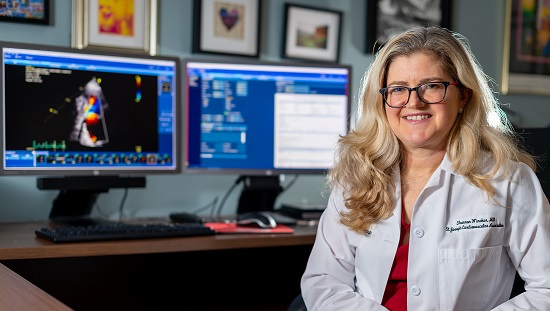Heart Care
Diagnosing Heart Conditions

Our team of cardiology specialists integrate advanced techniques and technologies to diagnose and treat a wide range of cardiac conditions.
Diagnostic Tests
Our cardiologists can perform or order a diagnostic test to determine your heart condition.
Treadmill Stress Test
The treadmill stress test measures the general strength of the heart and its capacity to "keep up" with the patient's level of activity. The test intentionally reproduces symptoms that the patient may encounter during physical exertion and evaluates chest pain that may or may not be heart-related (angina). Stress tests may also be conducted as part of a physical examination for healthy, middle-aged individuals to establish cardiac fitness levels for certain occupations or for sedentary individuals who want to begin a program of vigorous exercise, such as jogging.
Echocardiogram
An echocardiogram (echo) is a test that uses ultrasound waves to produce an image of the beating heart. It is typically a safe, painless procedure.
An echo reveals the size of the heart, its pumping strength, valve function and other important information to help the doctor determine the best course of action for care. It is one of the most common non-invasive techniques used in the diagnosis of heart disease today. In some cases, the doctor may inject a substance into an intravenous (IV) line to help get a better image of the heart's function during an echocardiogram.
Restrictions following an echocardiogram are minimal. Most people can eat and return to their normal routine when the test is completed.
Stress Echocardiogram
Also known as an exercise echocardiogram, this test combines an ultrasound study of the heart with an exercise test. This allows the doctor to learn more about how the heart functions when it works hard.
All areas of the heart muscle should pump more vigorously during exercise. If an area of the heart muscle doesn't pump as it should, it may mean that a blocked or narrowed artery is preventing enough blood from reaching the heart.
Transesophageal Echocardiogram
An echo exam through the esophagus provides a good view to the heart's action. The doctor can see a close-up image of the heart as it beats, as the valves open and close, and as the blood flows in and out.
A Transesophageal Echocardiogram (TEE) shows the valves that separate the upper and lower chambers of the heart, and the valves between the lower chamber and major arteries. ATTE also shows the holes or defects between chambers and gives doctors a chance to carefully examine major blood vessels.
TEE is often performed as an outpatient procedure in a hospital.
Diagnosing Irregular Heartbeats
The first step to evaluating the heart rhythm is to for the patient to have a physical exam and discussion with a doctor about their medical history. Then the patient will have an EKG exam. Next, the heart rhythm is captured using a portable monitor, which the patient wears for several weeks. Our cardiologists use the Zio™ monitor, which is only two and a half inches long, adheres to the body and is not noticeable under clothing. Patients can even swim and shower with this special heart monitor.
Contact Us
For more information, please call the Sandra R. Berman Heart Institute at 410-337-1216.
